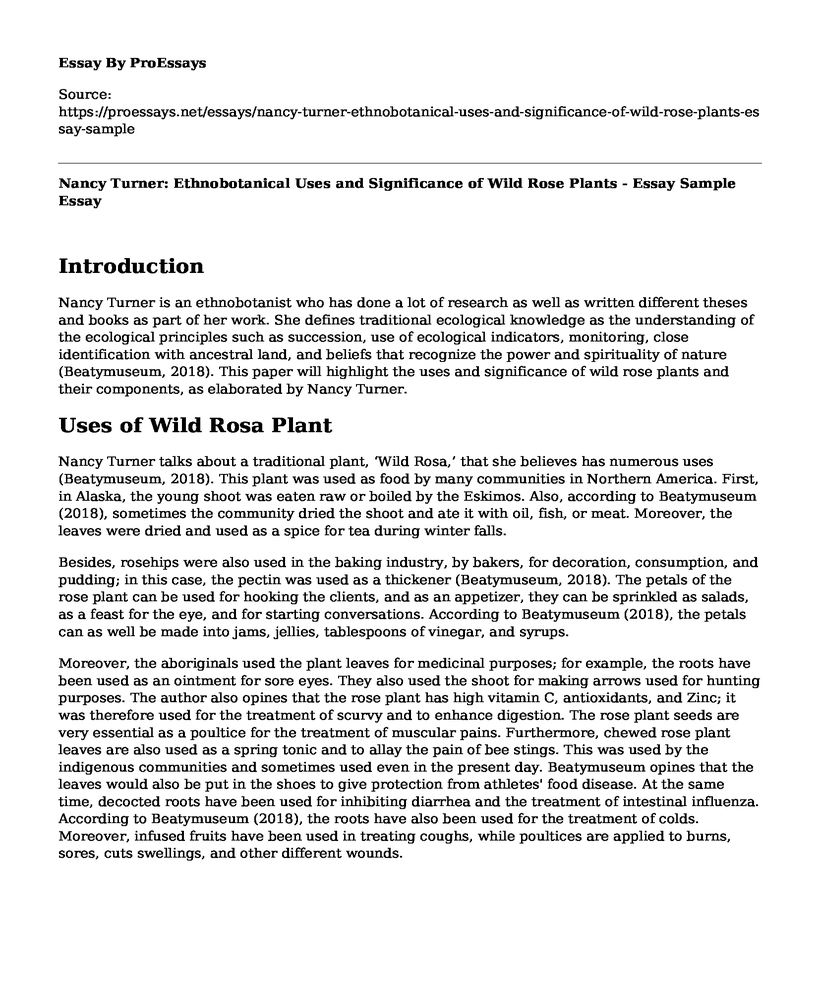Introduction
Nancy Turner is an ethnobotanist who has done a lot of research as well as written different theses and books as part of her work. She defines traditional ecological knowledge as the understanding of the ecological principles such as succession, use of ecological indicators, monitoring, close identification with ancestral land, and beliefs that recognize the power and spirituality of nature (Beatymuseum, 2018). This paper will highlight the uses and significance of wild rose plants and their components, as elaborated by Nancy Turner.
Uses of Wild Rosa Plant
Nancy Turner talks about a traditional plant, ‘Wild Rosa,’ that she believes has numerous uses (Beatymuseum, 2018). This plant was used as food by many communities in Northern America. First, in Alaska, the young shoot was eaten raw or boiled by the Eskimos. Also, according to Beatymuseum (2018), sometimes the community dried the shoot and ate it with oil, fish, or meat. Moreover, the leaves were dried and used as a spice for tea during winter falls.
Besides, rosehips were also used in the baking industry, by bakers, for decoration, consumption, and pudding; in this case, the pectin was used as a thickener (Beatymuseum, 2018). The petals of the rose plant can be used for hooking the clients, and as an appetizer, they can be sprinkled as salads, as a feast for the eye, and for starting conversations. According to Beatymuseum (2018), the petals can as well be made into jams, jellies, tablespoons of vinegar, and syrups.
Moreover, the aboriginals used the plant leaves for medicinal purposes; for example, the roots have been used as an ointment for sore eyes. They also used the shoot for making arrows used for hunting purposes. The author also opines that the rose plant has high vitamin C, antioxidants, and Zinc; it was therefore used for the treatment of scurvy and to enhance digestion. The rose plant seeds are very essential as a poultice for the treatment of muscular pains. Furthermore, chewed rose plant leaves are also used as a spring tonic and to allay the pain of bee stings. This was used by the indigenous communities and sometimes used even in the present day. Beatymuseum opines that the leaves would also be put in the shoes to give protection from athletes' food disease. At the same time, decocted roots have been used for inhibiting diarrhea and the treatment of intestinal influenza. According to Beatymuseum (2018), the roots have also been used for the treatment of colds. Moreover, infused fruits have been used in treating coughs, while poultices are applied to burns, sores, cuts swellings, and other different wounds.
Significance of The plant
The wild rose is a very important plant in the ecological food chain. The pollen grains are very essential food for many insects such as bees. Moreover, the rosehips are winter foods for birds and other animals such as waxwings, pine grosbeaks, grouse, rabbits, coyotes, and skunks (Beatymuseum, 2018).
According to Beatymuseum (2018), in ancient mythology, the wild rose plant was used as a powerful symbol for love and adoration. The male would present their spouse with a bouquet of wild rose to show their affection. Moreover, the wild rose plant was a symbol for a carrier of secrets; the Romans believed that any discussions that took place under hanging rose flowers were not to be talked about anywhere else as it was a taboo to do so.
Further, the wild rose plant has also been used for home and nature decorations (Beatymuseum, 2018). Within the homesteads or buildings, the plants have been arranged in a way to show the beauty and to give fragrance within the houses. The flowers produce a refreshing smell that is likable and acts as a natural perfume within the living rooms.
References
Beatymuseum (2018). YouTube. https://www.youtube.com/watch?v=oVpbv8BHmpQ&feature=emb_title
Cite this page
Nancy Turner: Ethnobotanical Uses and Significance of Wild Rose Plants - Essay Sample. (2023, Aug 10). Retrieved from https://proessays.net/essays/nancy-turner-ethnobotanical-uses-and-significance-of-wild-rose-plants-essay-sample
If you are the original author of this essay and no longer wish to have it published on the ProEssays website, please click below to request its removal:
- Essay Example on Human Cloning
- Paper Example on Parvocellular Stream and Motion Sensitivity Experiment
- Human Long Bone, Compact and Spongy Bone Paper Example
- Essay Sample on Metabolism and Urinary System
- Exploring Our Planet: Nature Films Uncover Vital Facts About Earth
- Essay Sample on Humans-Environment Interactions: A Constant Struggle for Survival
- Essay Example on Bone Composition & Development: A Comprehensive Guide







